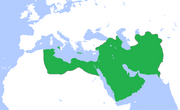
Flag of Abbasid Caliphate 750 AD/CE to 1517 AD/CE
Capitals: Kufa, Anbar, al-Rumiyyah, Baghdad, Raqqa, Samarra, Cairo

Continent: Asia
Official Languages: Classical Arabic
Established: 750 AD/CE
Disestablished: 1517 AD/CE
History:
The Abbasid caliphs were Arabs descended from Abbas ibn Abd al-Muttalib, one of the youngest uncles of Muhammad and of the same Banu Hashim clan. The Abbasids claimed to be the true successors of Prophet Muhammad in replacing the Umayyad descendants of Banu Umayya by virtue of their closer bloodline to Muhammad.
The Abbasids also distinguished themselves from the Umayyads by attacking their moral character and administration in general. According to Ira Lapidus, "The Abbasid revolt was supported largely by Arabs, mainly the aggrieved settlers of Merv with the addition of the Yemeni faction and their Mawali". The Abbasids also appealed to non-Arab Muslims, known as mawali, who remained outside the kinship-based society of the Arabs and were perceived as a lower class within the Umayyad empire. Muhammad ibn 'Ali, a great-grandson of Abbas, began to campaign in Persia for the return of power to the family of Prophet Muhammad, the Hashimites, during the reign of Umar II.
The first change the Abbasids, under Al-Mansur, made was to move the empire's capital from Damascus to a newly-founded city, Baghdad, in Iraq, closer to their Persian mawali support base, which addressed its demand for less Arab dominance in the empire. Baghdad was established on the Tigris River in 762. A new position, that of the vizier, was also established to delegate central authority, and even greater authority was delegated to local emirs. Caliph al-Mansur centralised the judicial administration, and later, Harun al-Rashid established the institution of Chief Qadi to oversee it.
This eventually meant that many Abbasid caliphs were relegated to a more ceremonial role than under the Umayyads, as the viziers began to exert greater influence, and the role of the old Arab aristocracy was slowly replaced by a Persian bureaucracy. During Al-Mansur's time control of Al-Andalus was lost, and the Shia revolted and were defeated a year later at the Battle of Bakhamra.
The Abbasids had depended heavily on the support of Persians in their overthrow of the Umayyads. Abu al-'Abbas' successor Al-Mansur welcomed non-Arab Muslims to his court. While this helped integrate Arab and Persian cultures, it alienated many of their Arab supporters, particularly the Khorasanian Arabs who had supported them in their battles against the Umayyads.
Al-Mu'tasim gained power in 833 and his rule marked the end of the strong caliphs. He strengthened his personal army with Turkish mercenaries and promptly restarted the war with the Byzantines. His military excursions were generally successful, culminating with a resounding victory in the Sack of Amorium. His attempt to seize Constantinople failed when his fleet was destroyed by a storm. The Byzantines restarted the fighting by sacking Damietta in Egypt. Al-Mutawakkil responded by sending his troops into Anatolia again, sacking and marauding until they were eventually annihilated in 863.
By the 870s, Egypt became autonomous under Ahmad ibn Tulun. In the East as well, governors decreased their ties to the center. The Saffarids of Herat and the Samanids of Bukhara had broken away from the 870s, cultivating a much more Persianate culture and statecraft. By this time only the central lands of Mesopotamia were under direct Abbasid control, with Palestine and the Hijaz often managed by the Tulunids. Byzantium, for its part, had begun to push Arab Muslims farther east in Anatolia.
By the 920s, the situation had changed further, as North Africa was lost to the Abbasids. A Shia sect only recognizing the first five Imams and tracing its roots to Muhammad's daughter Fatima took control of Idrisid and then Aghlabid domains. Called the Fatimid dynasty, they had advanced to Egypt in 969, establishing their capital near Fustat in Cairo, which they built as a bastion of Shia learning and politics. By 1000 they had become the chief political and ideological challenge to Sunni Islam in the form of the Abbasids. By this time the latter state had fragmented into several governorships that, while recognizing caliphal authority from Baghdad, did mostly as they wanted, fighting with each other. The Caliph himself was under 'protection' of the Buyid Emirs who possessed all of Iraq and western Iran, and were quietly Shia in their sympathies.
Despite the power of the Buyid amirs, the Abbasids retained a highly ritualized court in Baghdad, as described by the Buyid bureaucrat Hilal al-Sabi', and they retained a certain influence over Baghdad as well as religious life. As Buyid power waned with the rule of Baha' al-Daula, the caliphate was able to regain some measure of strength. The caliph al-Qadir, for example, led the ideological struggle against the Shia with writings such as the Baghdad Manifesto. The caliphs kept order in Baghdad itself, attempting to prevent the outbreak of fitnas in the capital, often contending with the ayyarun.
With the Buyid dynasty on the wane, a vacuum was created that was eventually filled by the dynasty of Oghuz Turks known as the Seljuqs. By 1055, the Seljuqs had wrested control from the Buyids and Abbasids, and took any remaining temporal power. When the amir and former slave Basasiri took up the Shia Fatimid banner in Baghdad in 1056–57, the caliph al-Qa'im was unable to defeat him without outside help. Toghril Beg, the Seljuq sultan, restored Baghdad to Sunni rule and took Iraq for his dynasty.
While the Caliph al-Mustarshid was the first caliph to build an army capable of meeting a Seljuk army in battle, he was nonetheless defeated in 1135 and assassinated. The Caliph al-Muqtafi was the first Abbasid Caliph to regain the full military independence of the Caliphate, with the help of his vizier Ibn Hubayra. After nearly 250 years of subjection to foreign dynasties, he successfully defended Baghdad against the Seljuqs in the siege of Baghdad (1157), thus securing Iraq for the Abbasids. The reign of al-Nasir (d. 1225) brought the caliphate back into power throughout Iraq, based in large part on the Sufi futuwwa organizations that the caliph headed. Al-Mustansir built the Mustansiriya School, in an attempt to eclipse the Seljuq-era Nizamiyya built by Nizam al Mulk.
In 1206, Genghis Khan established a powerful dynasty among the Mongols of central Asia. During the 13th century, this Mongol Empire conquered most of the Eurasian land mass, including both China in the east and much of the old Islamic caliphate (as well as Kievan Rus') in the west. Hulagu Khan's destruction of Baghdad in 1258 is traditionally seen as the approximate end of the Golden Age. Mongols feared that a supernatural disaster would strike if the blood of Al-Musta'sim, a direct descendant of Muhammad's uncle Abbas ibn Abd al-Muttalib, and the last reigning Abbasid caliph in Baghdad, was spilled. The Shia of Persia stated that no such calamity had happened after the death of Husayn ibn Ali in the Battle of Kerbala; nevertheless, as a precaution and in accordance with a Mongol taboo which forbade spilling royal blood, Hulagu had Al-Musta'sim wrapped in a carpet and trampled to death by horses on 20 February 1258. The Caliph's immediate family was also executed, with the lone exceptions of his youngest son who was sent to Mongolia, and a daughter who became a slave in the harem of Hulagu.
In the 9th century, the Abbasids created an army loyal only to their caliphate, composed of non-Arab origin people, known as Mamluks. This force, created in the reign of al-Ma'mun (813–833) and his brother and successor al-Mu'tasim (833–842), prevented the further disintegration of the empire. The Mamluk army, though often viewed negatively, both helped and hurt the caliphate. Early on, it provided the government with a stable force to address domestic and foreign problems. However, creation of this foreign army and al-Mu'tasim's transfer of the capital from Baghdad to Samarra created a division between the caliphate and the peoples they claimed to rule. In addition, the power of the Mamluks steadily grew until al-Radi (934–941) was constrained to hand over most of the royal functions to Muhammad ibn Ra'iq.
The Mamluks eventually came to power in Egypt. In 1261, following the devastation of Baghdad by the Mongols, the Mamluk rulers of Egypt re-established the Abbasid caliphate in Cairo. The first Abbasid caliph of Cairo was Al-Mustansir. The Abbasid caliphs in Egypt continued to maintain the presence of authority, but it was confined to religious matters.The Abbasid caliphate of Cairo lasted until the time of Al-Mutawakkil III, who was taken away as a prisoner by Selim I to Constantinople where he had a ceremonial role. He died in 1543, following his return to Cairo.